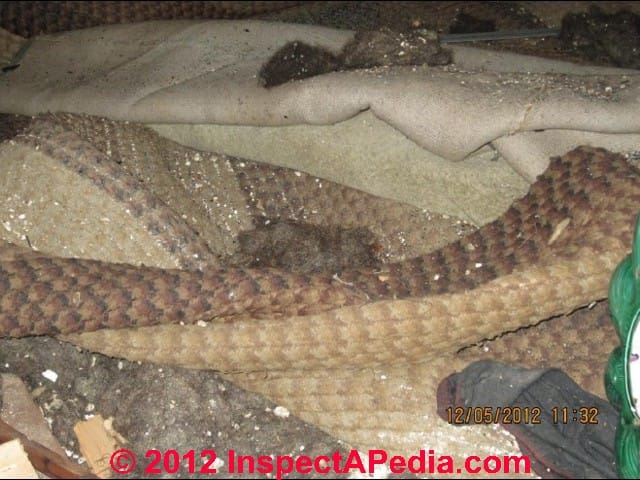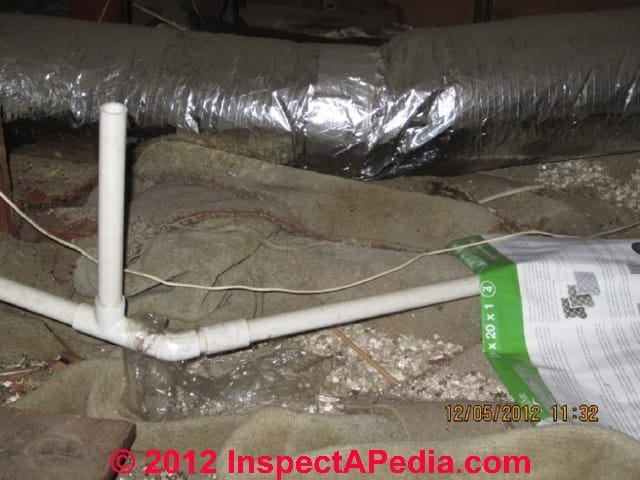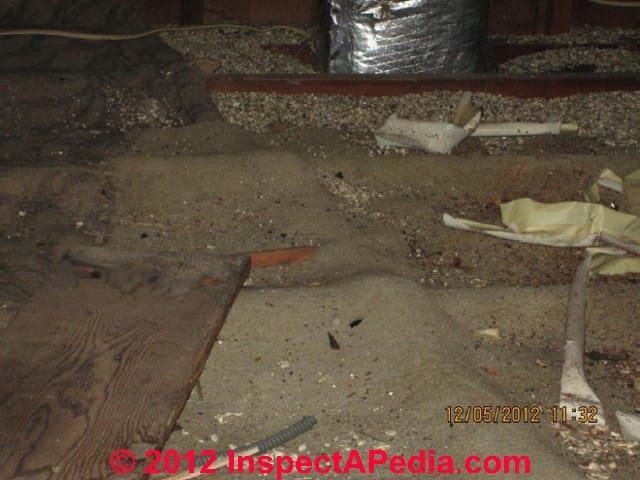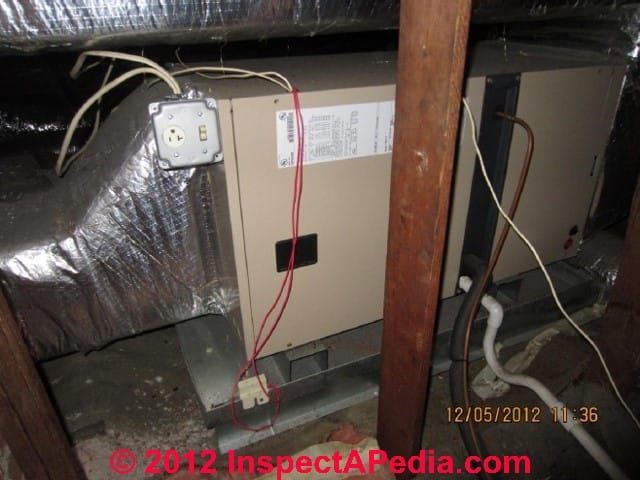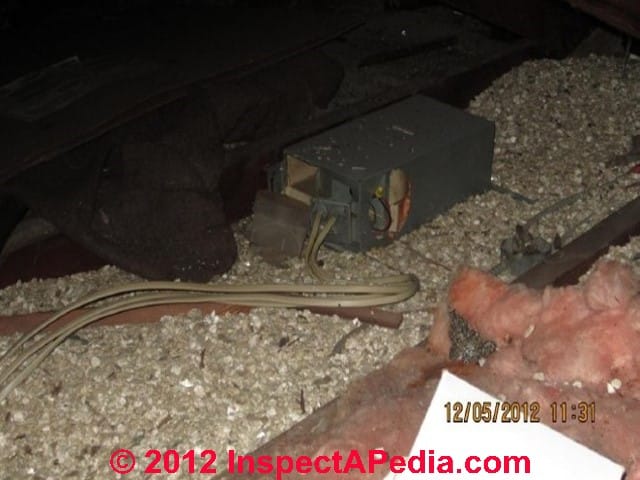 Vermiculite Building Insulation Action Recommendations
Vermiculite Building Insulation Action Recommendations
What to do about Vermiculite Insulation & Zonolite Insulation ZAI in Buildings
- POST a QUESTION or COMMENT about vermiculite insulation & asbestos content of vermiculite
Vermiculite insulation action: what to do about vermiculite insulation in buildings:
What should be done about potential vermiculite-asbestos hazards ascribed to Zonolite ZAI attic insulation? Should the vermiculite insulation be removed, encapsulated, sealed, or left alone?
This article series explains how to recognize vermiculite building insulation that may contain asbestos fibers.
We provide photographs and descriptive text of asbestos insulation and other asbestos-containing products to permit identification of definite, probable, or possible asbestos materials in buildings.
We include US EPA advice about what to do if asbestos-containing vermiculite insulation is in your building.
InspectAPedia tolerates no conflicts of interest. We have no relationship with advertisers, products, or services discussed at this website.
- Daniel Friedman, Publisher/Editor/Author - See WHO ARE WE?
What to Do About Zonolite or Other Vermiculite Building Insulation
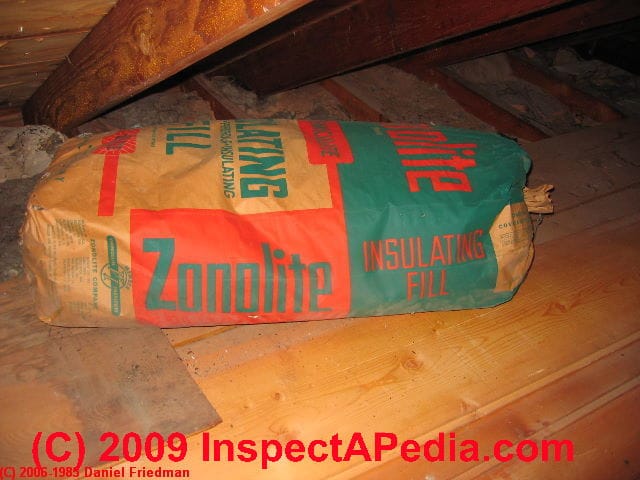 Article Contents
Article Contents
Health Canada Information on Vermiculite Insulation Hazards in Canada
The following advice is adapted & excerpted from Health Canada's vermiculite risk minimization advice, cited below. Note that the advice presumes or pertains to vermiculite insulation that contains amphibole asbestos. That determination can be made only by a laboratory test.
The best way to minimize your risk of amphibole asbestos exposure is to avoid disturbing vermiculite-based insulation in any way. If vermiculite-based insulation is contained and not exposed to the home or interior environment, it poses very little risk.
Do not use the attic for storage if retrieving items from it may disturb the insulation. If you must go into the attic, walk on boards in order to minimize disturbance of the insulation and use an appropriate respirator mask. Do not remain in the attic any longer than is necessary.
Do not allow children to play in an attic with open areas of vermiculite-based insulation and make sure anyone working in the attic knows about the possible presence of amphibole asbestos.
Common dust masks are not effective against asbestos fibres. [You would need to wear a HEPA filter respirator and you would need to take care not to track potentially hazardous dust into other building areas - Ed.]
If you have vermiculite-based insulation and you decide to have it removed, speak to trained and qualified asbestos removal professionals to handle the insulation removal. They can be found by looking up experts in "asbestos abatement /removal." NEVER attempt to remove the insulation yourself.
[See WARNINGS BEFORE REMOVING VERMICULITE INSULATION - Ed.]
If you plan to remodel or renovate--for instance, by re-insulating your attic--in a manner that would disturb the vermiculite, speak to professionals who are trained and qualified to handle asbestos removal before proceeding with the work to be done.
Seal all cracks and holes in the ceilings of the rooms below the insulation (for example, apply caulking around light fixtures and the attic hatch) to prevent insulation sifting through.
If you suspect you have vermiculite-based insulation in your walls, as a precautionary step, seal all cracks and holes. For example, apply caulking around window and door frames, along baseboards and around electrical outlets.
- Health Canada, 26 March 2015, original source: http://www.hc-sc.gc.ca/hl-vs/iyh-vsv/prod/insulation-isolant-eng.php
Thanks to Alan Carson, Carson Dunlop Associates, a Toronto home inspection & inspector education firm for correspondence and references on vermiculite insulation hazards.
US EPA Advice on Vermiculite Insulation
Quoting from the U.S. EPA advice on vermiculite:
Why should I be concerned about asbestos-contaminated vermiculite insulation?
A mine near Libby, Montana was the source of over 70 percent of all vermiculite sold in the U.S. from 1919 to 1990. There was also a deposit of asbestos at that mine, so the vermiculite from Libby was contaminated with asbestos.
Vermiculite from Libby was used in the majority of vermiculite insulation in the U.S. and was often sold under the brand name Zonolite.
If you have vermiculite insulation in your home, you should assume this material may be contaminated with asbestos and be aware of steps you can take to protect yourself and your family from exposure to asbestos.
- original source: http://www.epa.gov/asbestos/pubs/verm.htm
[See WARNINGS BEFORE REMOVING VERMICULITE INSULATION - Ed.]
Protect Your Family from Asbestos-Contaminated Vermiculite Insulation
Vermiculite is a naturally occurring mineral composed of shiny flakes, resembling mica. When heated to a high temperature, flakes of vermiculite expand as much as 8-30 times their original size. The expanded vermiculite is a light-weight, fire-resistant, and odorless material and has been used in numerous products, including insulation for attics and walls.
Sizes of vermiculite products range from very fine particles to large (coarse) pieces nearly an inch long. A mine near Libby, Montana, was the source of over 70 percent of all vermiculite sold in the U.S. from 1919 to 1990. There was also a deposit of asbestos at that mine, so the vermiculite from Libby was contaminated with asbestos.
Vermiculite from Libby was used in the majority of vermiculite insulation in the U.S. and was often sold under the brand name Zonolite [image].
If you have vermiculite insulation in your home, you should assume this material may be contaminated with asbestos and be aware of steps you can take to protect yourself and your family from exposure to asbestos. This Web page provides important information on how to protect yourself and your family if you suspect that you might have vermiculite insulation from Libby, Montana.
Warnings To Consider Before Removing Vermiculite Building Insulation
Watch out: in our opinion, after reviewing the research literature on vermiculite insulation and Zonolite, there are some remaining risks and open questions that consumers should consider when approaching the removal and "remediation" of vermiculite as a hazardous building substance.
It appears that the ZAI claims website information suggests that building owners or tenants may be offered financial relief for the removal of any vermiculite insulation that was or is in buildings within the United States as long as the tenants or owners can provide the documentation required by the claims procedure. [We have asked the claims administrator for clarification on this point.]
That documentation does not require proof that the vermiculite insulation being considered actually was Zonolite nor that it contained asbestos - perhaps because such proof is impossible to establish in many cases such as when the material has already been removed. Therefore it would appear that the claims trust may be burdened by claims to remove vermiculite that did not contain asbestos.
But the total amount of financial assistance available to building tenants or ownes where vermiculite insulation was installed is likely to be a small portion of the total cost of removing loose-fill poured-in vermiculite insulation in a building when that insulation has to be treated as an asbestos-containing material. Such treatment requires costly containment and removal and disposal measures.
In sum, it would make sense to avoid such significant expense if the vermiculite insulation in your building is not harmful.
- Test representative samples
of your vermiculite insulation before assuming that it contains asbestos and thus before assuming that the material needs to be removed or addressed at all.
See ASBESTOS TESTING LAB LIST
Not all vermiculite insulation sold and installed in buildings in North America contained asbestos and as you can read at research on this topic, the actual level of asbestos even in Zonolite insulation was generally low. Research indicates that the chief health risks faced by workers at the Libby mine or in vermiculite processing facilities may not extend to the general population in buildings not located near those mining or fabricating facilities.
See VERMICULITE INSULATION INCIDENTAL EXPOSURE HAZARDS ? - Avoid unnecessary removal of harmless vermiculite insulation:
if your vermiculite insulation does not contain asbestos it does not need to be removed. - If your vermiculite insulation does contain asbestos and is an encapsulated, sealed area
(such as a wall cavity) the chances of being exposed to harmful dust from that material may be below the limits of detection.
While the EPA has issued warnings about loose-fill Zonolite insulation, for example in attics where people might enter and disturb it, in general the US EPA's advice about asbestos hazards is that the hazard is least when the material is un-disturbed and encapsulated.
The disturbance of unnecessary removal may create a greater hazard than had such material been left alone. - If your vermiculite insulation is confirmed as containing asbestos and is in a risky location or condition
such that it should be professionally removed be sure to use a licensed, qualified asbestos abatement contractor, and be sure to keep the appropriate documentation, not only to assist in a claim but to protect the property value in the event of a subsequent re-sale.
Photographs & Examples of What NOT to do in a home when you have vermiculite in the attic
Mr. Grudzinski continues with an example of vermiculite insulation that had been missed by previous occupants, owners, buyers of a building.
It appears that some contractors still have no clue how to work around attic insulation, and this home has paid the price. The occupants had no clue and when I arrived and saw what was done, many long faces were observed.
The worst thing you can do when you have Vermiculite in an attic is to allow the bath fan to be blowing the product around.
Vermiculite, depending on its source, (from the Grace mine in Libby Montana) contains tremolite asbestos.
For anyone who doesn't’t know the history, serious health and life safety hazards affected mine workers and others exposed to high levels of asbestos dust; millions of dollars in corrections were spent to clean up the site.
The vermiculite insulation product sold under the name Zonolite contained significant levels of asbestos, and was shipped all over the country for use as building insulation, even refrigeration system insulation, and for use in other applications.
Apparently this home owner had no idea of the potential hazard of asbestos dust in his/her home, and allowed this bath fan to blow the vermiculite insulation and its finer dust particles around for years.
The attic hatch from which I took the photo, is a pull down stair. Pull-down attic stairs do not provide an air seal between the attic and the occupied space.
Further, under some conditions (such as when air conditioning is in use at a building, air (and attic dust) can be drawn downwards from an attic space into the occupied building areas.
In my opinion there is a high probability that asbestos may have been released in the living space of this home.
To make matters worse, all sorts of fabric and carpets were tossed in the attic, and as you see in five vermiculite insulation and insulation contamination photos shown here, the vermiculite was disturbed and is on top of the fabric and is scattered everywhere.
To remove the fabric and debris, one will have to disturb the Vermiculite further.
Worse, bringing carpeting (below right) or other items stored in the attic down into the living area means importing vermiculite insulation (reasonably treated as Presumed Asbestos Containing Material or PACM) into the occupied space as well.
Justification for treating any vermiculite building insulation in the U.S. as PACM comes from the U.S. EPA who point out (later in this article) that Zonolite comprised about 70% of vermiculite insulation sold in the U.S.
Continuing my inspection it was apparent that the air conditioning system air duct (upper center in the photo at above right) passes through the ceiling and down into a closet below. (Second of the next two photos).
The question arose: how well was that ceiling penetration (above left) sealed against the passage of insulation, air or dust from the attic as it entered the closet (below left)?
I found not a shred of evidence that any measures had ever been taken to contain the vermiculite insulation, and it has spilled into the living space as you can see in our next photograph.
Evidence of Vermiculite & PACM (Asbestos) Entering the Living Space
Even at the time of my inspection, vermiculite insulation was seen falling out of the closet ceiling and onto closet contents as well as the closet floor (photo at left) because AC duct was installed in this space.
These conditions - vermiculite insulation and dust entering the occupied space of the building have almost certainly been ongoing for decades.
The actual level of airborne vermiculite (and very likely asbestos) dust would have varied as building air movement conditions varied, and would most likely have been highest when fans and/or the central air conditioning system were in operation.
In the attic the A/C system air handler in the attic is sitting in and on vermiculite insulation.
The A/C return air duct was observed to have vermiculite inside.
This condition virtually guarantees that airborne insulation (and presumably asbestos) dust and fragments would have been drawn into and sent through the air conditioning duct system whenever the air handler blower was operating.
What Should the Building Inspector or Owner Do About Suspected or Known Vermiculite Insulation & Presumed Asbestos Dust Contamination?
Extensive asbestos testing and repairs will be needed in this house.
We [OPINION - InspectApedia] would recommend a professional assessment of the extent of asbestos dust contamination in the building, including settled dust not just airborne dust, and almost certainly professional cleaning of the HVAC system and possibly other building areas are going to be in order.
When a home inspector sees loose vermiculite in a building during an inspection, we recommend not entering such an attic without wearing a HEPA respirator and a TYVEK suit that is bagged and disposed-of (in your home garbage not that at the property) on leaving the attic. If you didn't wear tyvek, dust off outside and wash your clothes.
Those steps minimize the risk of importing PACM dust into other areas or buildings.
David Grudzinski, Advantage Home Inspections, is a professional home inspector who contributes on various topics including structural matters. Mr. Grudzinski, Cranston RI serving both Rhode Island and Eastern Connecticut can be reached at 401-935-6547 fax- 401-490-0607 or by email to Davidgrudzinski@aol.com
See WARNINGS BEFORE REMOVING VERMICULITE INSULATION
Should You Remove Vermiculite Building Insulation?
 Usually it is safest to leave asbestos containing materials alone and un-disturbed.
Usually it is safest to leave asbestos containing materials alone and un-disturbed.
Question: vermiculite came from the Libby mine and contains >1% Actinolite. What should we do?
2017/04/15 Susan Dena said:
Had it tested and the vermiculite came from the Libby mine and contains >1% Actinolite. Besides having AC, bathroom fan we have an exhaust fan in the attic vents should we have that? Not sure what to do!
Reply:
Susan
Your inspector will no doubt take a look at where vermiculite insulation has been used in your home in order to identify the possible pathways that vermiculite or vermiculite dust might be drawn into the building HVAC system or the indoor air in occupied spaces.
Your approaches are to either close or seal such passages (such as an air leak in return ducts passing through an attic insulated with vermiculite) or to try a much more risky approach of having the insulation removed and the entire insulated space cleaned and HEPA vacuumed, followed by re-insulation.
The risk of such an approach is that disturbing the material usually creates a greater hazard than if it were left alone.
See WARNINGS BEFORE REMOVING VERMICULITE INSULATION for more detail.
Example:
In an attic that is regularly accessed (perhaps for storage) and that has vermiculite in its floor, one might seal any penetrations in the ceiling below and then install a tight floor covering over the ceiling joists on the attic side.
We looked for expert sources recommending best practices for dealing with asbestos-containing vermiculite insulation.
At www.epa.gov/asbestos/protect-your-family-asbestos-contaminated-vermiculite-insulation the US EPA advises
If You Have Vermiculite Insulation
YOU SHOULD ASSUME THE VERMICULITE CONTAINS ASBESTOS AND DO NOT DISTURB IT!
Any disturbance could potentially release asbestos fibers into the air.
If you absolutely have to go in your attic and it contains vermiculite insulation, you should limit the number of trips you make and shorten the length of those trips in order to help limit your potential exposure.
We [the U.S. EPA] recommend that you:
- Leave vermiculite insulation undisturbed in your attic or in your walls.
- Do not store boxes or other items in your attic if it contains vermiculite insulation.
- Do not allow children to play in an attic with vermiculite insulation.
- Do not attempt to remove the insulation yourself.
- Hire a professional asbestos contractor if you plan to remodel or conduct renovations that would disturb the vermiculite in your attic or walls to make sure the material is safely handled and/or removed.
Possibly due to the current U.S. EPA leadership and environmental policies, the US EPA advice for BEST PRACTICES for VERMICULITE INSULATION is a blank page except for two photos. I'll attach today's screen shot.
Also of interest to readers:
- VERMICULITE HANDLING, HAZARD, ADVICE RESEARCH - full list of advice articles & procedures for U.S. & Canadian building owners where Vermiculite insulation is found.
- US EPA ADVICE for VERMICULITE SAMPLING for ASBESTOS [PDF] (2004) and
- ZAI Trust, web: zonoliteatticinsulation.com/S/General-Information
Excerpt: The ZAI Trust was created for the benefit of homeowners with the ZONOLITE brand of vermiculite attic insulation. Specifically, Trust funds are used to reimburse homeowners a portion of their cost to remove or contain Zonolite attic insulation .
In order to be eligible for reimbursement a claimant must be able to show:
That vermiculite is the Zonolite Brand. This is called the Product Identification (PID) requirement AND
How much was paid to have the vermiculite removed or contained. This is called the Expense Requirement.
Financial Aid for Removing Zonolite (Asbestos-containing) Vermiculite Building Inslation
If you are planning remodeling or other building activity that requires actual removal of asbestos-containing vermiculite insulation, The Zonolite Attic Insulation Trust was established to provide some financial help with the cost of removing Zonolite Attic Insulation. The trust will reimburse homeowners for 55% of their removal and re-insulation costs, up to $4,125.
ZAI Trust, web: zonoliteatticinsulation.com/S/General-Information
Excerpt: The ZAI Trust was created for the benefit of homeowners with the ZONOLITE brand of vermiculite attic insulation. Specifically, Trust funds are used to reimburse homeowners a portion of their cost to remove or contain Zonolite attic insulation .
In order to be eligible for reimbursement a claimant must be able to show:
That vermiculite is the Zonolite Brand. This is called the Product Identification (PID) requirement AND
How much was paid to have the vermiculite removed or contained. This is called the Expense Requirement.
Contact the ZAI (Zonolite Attic Insulation Trust) at
- The Zonolite Attic Insulation Trust ZAI, 317 Wingo Way, Suite 303, Mt. Pleasant, SC 29464 USA Tel: (844) ZAI-CALL Email: info@zaitrust.com Website: https://www.zonoliteatticinsulation.com/
- ZAI CLAIM FORM & INSTRUCTIONS [PDF]
I have been vacuuming up vermiculite insulation on my own
I just recently found out that our attic insulation is vermiculite. We have owned our home for over 23 years and have installed central air conditioning in the attic and our bathroom exhaust fan is connect up in the attic. We have found fallen insulation thru the years in our central air vents, bathroom fan and our children’a closets
I have vacuum this up several times over the years. I now am so concerned that I have exposed my family to this. Your opinion is appreciated. (Mar 6, 2018) Susan Deno
Reply:
Susan,
If vermiculite insulation has spilled into your home and thus must be cleaned-up, you can do a better and safer cleaning job using a HEPA-rated vacuum cleaner and damp-wiping dusty suspect-surfaces.
To know for sure if you have stirred up asbestos-containing material you'd need to either know the brand of vermiculite that was installed (perhaps finding a label or bag) or you'd need to have a sample tested for asbestos - use the page top EXPERTS DIRECTORY to find an asbestos test lab.
What to do about vermiculite in an attic with a pull-down attic access stair
We've owned our home for 7 years and recently found out that the vermiculite insulation in our attic contain asbestos. Our attic hatch is located in our garage (house is a ranch style).
It hasn't had the scuttle door on it since we bought it. Now I'm afraid the vermiculite dust may have contaminated the garage! Is that possible just by leaving the access open? - (Jan 20, 2017) Dave
I have vermiculite in my attic as well. It tested positive for asbestos and we decided to just leave it alone. My concern now is after reading this article, that I'm contaminating the inside of my home! I have pull down attic stairs and run my A/C in the warmer months! Am I really pulling attic air into my home? - (May 14, 2017) Ann
Reply:
Dave and Ann:
If there is a pull-down hatch into an attic filled with loose asbestos-containing insulation it'd be easy for people passing in and out of the attic to kick down or track loose insulation into the attic.
There are also a few cases where attic air moves downward - cool air falling down a stairwell, for example can on occasion draw warmer air out of a higher space - both in theory and in practice.
So if you're not going to clean out the insulation you might want to close and seal the attic pull down stair cover-hatch and not permit regular use of that space.
You can have a settled dust sample from your garage tested for asbestos. That will tell you if additional cleaning would be appropriate for that space.
Meanwhile do not run a normal vacuum cleaner in the garage nor track its dirt and debris indoors.
If the insulation was disturbed by pushing it around, walking on it, or placing stored items on it and then bringing them down into occupied space you may have imported dust from the garage attic and that may have included some asbestos.
Most-likely the level of asbestos dust risk and hazard from a mere open hatch to a garage attic where vermiculite insulation is present is low but of course I can't see nor assess your home by a brief e-text.
If you observe significant dust levels int he garage that you think came from the attic, a simple and sensible test would be to use clear adhesive tape to send a dust sample to a certified asbestos test lab.
See DUST SAMPLING PROCEDURE at inspectapedia.com/sickhouse/Dust_Sampling_Guide.php
and
Search InspectApedia for ASBESTOS TEST LABS to see how to find one - the cost is about $40. USD.Ann
By no means do we want anyone to panic about vermiculite insulation, even if it is tested and confirmed to contain asbestos.
The first question is to determine if there are leaks or passages that send the insulation and its dust into the occupied space of the home or into its HVAC ducts. That requires a competent onsite inspection.
Only if there were leaks into return air ducts in an attic (those can be sealed) or if some idiot put a cold air return inlet in the attic (highly unusual) would I be so worried about the duct system itself.
But you also want to take care that people are not spilling, knocking, or tracking insulation into the building's occupied space.
Reader follow-up: high probability that asbestos may have been released in the living space of this home
(May 14, 2017) Ann said:
Thank you for your quick response. My HVAC system isn't in my attic, thank goodness, but here's why I was concerned...from your article above, "The attic hatch from which I took the photo, is a pull down stair.
Pull-down attic stairs do not provide an air seal between the attic and the occupied space.
Further, under some conditions (such as when air conditioning is in use at a building, air (and attic dust) can be drawn downwards from an attic space into the occupied building areas
In my opinion there is a high probability that asbestos may have been released in the living space of this home.
Reply:
Test the home's settled dust (or hire an environmental test expert to do that for you.)
See DUST SAMPLING PROCEDURE at inspectapedia.com/sickhouse/Dust_Sampling_Guide.php
See ASBESTOS TESTING LAB LIST to see how to find a certified asbestos test laboratory - the cost is about $40. USD.That will tell you if further expert cleanup would be appropriate.
What to do with a home with forced hot air and vermiculite insulation?
I appreciate the plethora of information on your website. Do you have other recommendations for what to do with a home with forced hot air and vermiculite insulation? I am not certain if this pertains to VAI or if the insulation was also blown into the walls. (July 12, 2016) KD, Hartford CT
Reply:
KD
There should be no situation in which forced hot air systems are blowing the system air across loose fill nor any other kind of insulation, nor should the forced hot air system be drawing return air from a space exposed to insulation.
IF, however, leaky return-air ducts pass through vermiculite-insulated areas, those ducts should be sealed and then cleaned on their interior (without disturbing the vermiculite insulation itself).
If vermiculite loose-fill insulation was blown into building walls, as those cavities would not be in the air path of the heating system air ducts that ought not be a concern.
I'd need to better understand the situation you are facing to comment further.
You can attach photos to Comments (below) or you can also use the page top or bottom CONTACT link to send us photos of your situation and perhaps we can comment further.
...
...
Continue reading at VERMICULITE INSULATION INCIDENTAL EXPOSURE HAZARDS ? or select a topic from the closely-related articles below, or see the complete ARTICLE INDEX.
Or see these
Recommended Articles
- ASBESTOS TESTING LAB LIST
- INSULATION IDENTIFICATION GUIDE
- VERMICULITE INSULATION - home
- HOW TO IDENTIFY VERMICULITE INSULATION
- MICA-FIL, MUNN & STEELE, CALIFORNIA, CANADA, & SISCO VERMICULITE ASBESTOS
- WHAT TO DO ABOUT VERMICULITE INSULATION
- VERMICULITE HISTORY & PROPERTIES
- VERMICULITE INSULATION INCIDENTAL EXPOSURE HAZARDS ?
- ZONOLITE BRAND VERMIULITE INSULATION ZAI & CLAIMS
Suggested citation for this web page
WHAT TO DO ABOUT VERMICULITE INSULATION at InspectApedia.com - online encyclopedia of building & environmental inspection, testing, diagnosis, repair, & problem prevention advice.
Or see this
INDEX to RELATED ARTICLES: ARTICLE INDEX to ASBESTOS HAZARDS
Or use the SEARCH BOX found below to Ask a Question or Search InspectApedia
Ask a Question or Search InspectApedia
Questions & answers or comments about vermiculite insulation & asbestos.
Try the search box just below, or if you prefer, post a question or comment in the Comments box below and we will respond promptly.
Search the InspectApedia website
Note: appearance of your Comment below may be delayed: if your comment contains an image, photograph, web link, or text that looks to the software as if it might be a web link, your posting will appear after it has been approved by a moderator. Apologies for the delay.
Only one image can be added per comment but you can post as many comments, and therefore images, as you like.
You will not receive a notification when a response to your question has been posted.
Please bookmark this page to make it easy for you to check back for our response.
IF above you see "Comment Form is loading comments..." then COMMENT BOX - countable.ca / bawkbox.com IS NOT WORKING.
In any case you are welcome to send an email directly to us at InspectApedia.com at editor@inspectApedia.com
We'll reply to you directly. Please help us help you by noting, in your email, the URL of the InspectApedia page where you wanted to comment.
Citations & References
In addition to any citations in the article above, a full list is available on request.
- [1] Thanks to Gary Randolph, Ounce of Prevention Home Inspection, LLC Buffalo, NY, for attentive reading and editing suggestions. Mr. Randolph can be reached in Buffalo, NY, at (716) 636-3865 or email: gary@ouncehome.com, March 2007
- [2] Thanks for photographs of transite asbestos heating ducts, courtesy of Thomas Hauswirth, Managing Member of Beacon Fine Home Inspections, LLC and (in 2007) Vice President, Connecticut Association of Home Inspectors Ph. 860-526-3355 Fax 860-526-2942 beaconinspections@sbcglobal.net, June 2007
- [3] Thanks to home inspector Dan Phillips, Advanced Home Inspections, at P.O. Box 1068 Olive Branch, MS 38654-1068 , (901) 229-0822 email: dan@midsouthahi.com 05/29/2010
- [4] David Grudzinski, Advantage Home Inspections, ASHI cert # 249089, HUD cert# H-145, is a professional home inspector who contributes on various topics including structural matters. Mr. Grudzinski, Cranston RI serving both Rhode Island and Eastern Connecticut can be reached at 401-935-6547 fax- 401-490-0607 or by email to Davidgrudzinski@aol.com. Mr. Grudzinski is a regular contributor to InspectAPedia.com - See DECK FLASHING LEAKS, ROT Case Study, and BASEMENT WATER MOLD IMPACT and VERMICULITE INSULATION for examples.
- [5] Vermiculite: Protect Your Family from Asbestos-Contaminated Vermiculite Insulation, U.S. EPA, web search 08/17/2010, original source: http://www.epa.gov/asbestos/pubs/verm.html
- [6] HOJA INFORMATIVA - Proteja a su familia del aislante de vermiculita contaminado con asbestos, web search 08/17/2010, original source http://www.epa.gov/asbestos/pubs/verm-ques-sp.pdf
- [7] Vermiculite Insulation Containing,
Amphibole Asbestos [PDF], Health Canada, September 2009, web search Jan 2011, source: http://www.hc-sc.gc.ca/hl-vs/iyh-vsv/prod/insulation-isolant-eng.php [copy on file as /hazmat/Vermiculite_Health_Canada.pdf] Vermiculite Insulation Containing Amphibole Asbestos - September 2009, Health Canada Quoting from the PDF document:
Some vermiculite insulation may contain amphibole asbestos fibres. These products can cause health risks if disturbed during maintenance, renovation or demolition. However, there is currently no evidence of risk to your health if the insulation is sealed behind wallboards and floorboards, isolated in an attic, or otherwise kept from exposure to the interior environment. - [8] Vermiculite:
Protect Your Family from Asbestos-Contaminated Vermiculite Insulation, U.S. EPA , web search 08/17/2010, original source: http://www.epa.gov/asbestos/pubs/verm.html [copy on file as /hazmat/Vermiculite_US_EPA.pdf/ Current Best Practices for Vermiculite Attic Insulation - May 2003, U.S. EPA
Web search 01/20/2011, original source: http://epa.gov/asbestos/pubs/verm_questions.html- Proteja su familia del aislante de vermiculita contaminado con asbestos, U.S. EPA HOJA INFORMATIVA - Proteja a su familia del aislante de vermiculita contaminado con asbestos, web search 08/17/2010, original source http://www.epa.gov/asbestos/pubs/verm-ques-sp.pdf
- [10] "Zonolite Attic Insulation Safety Facts", W.R. Grace Corporation, web search 5/1/2012, original source: http://www.grace.com/about/ehs/libby/zonolite.aspx, [copy on file as /2 Environmental Hazards/Asbestos/Zonolite_Grace_Info.pdf ]
- [11] "Libby Timeline", W.R. Grace Corporation, web search 4/28/12, original source :http://www.grace.com/about/ehs/libby/timeline.aspx
[copy on file as [Libby_History_Grace.pdf] - [12]Asbestos Identification, Walter C.McCrone, McCrone Research Institute, Chicago, IL.1987 ISBN 0-904962-11-3. Dr. McCrone literally "wrote the book" on asbestos identification procedures which formed the basis for current work by asbestos identification laboratories.
- [13] Stanton, .F., et al., National Bureau of Standards Special Publication 506: 143-151
- [14] Pott, F., Staub-Reinhalf Luft 38, 486-490 (1978) cited by McCrone
- [15] "Financial Reorganization", W.R. Grace corporation, web search 5/8/11, original source: http://www.grace.com/About/Reorganization.aspx, [copy filed as /Grace_Financial_Reorg.pdf]
- [16] The Perlite Institute, Inc., 4305 North Sixth Street Suite A Harrisburg, PA 17110, Tel: 717-238-9723, Fax: 717-238-9985, Email: info@perlite.org, Website: http://www.perlite.org/
- [17] Schundler Company, Edison, NJ 732-287-2244 email: info@schundler.com Schundler provides information about the application-use of both perlite and vermiculite insulation products.
Vermiculite MSDS for Schundler's vermiculite product - [18] "Coping With Suspect Insulation", Jay Romano, The New York Times, 8 June 2003, p. 7
- [19] "Hazardous Materials: EPA’s Assessment of Sites that May Have Received Asbestos-Contaminated Ore from Libby, Montana (GAO-09-7sp, March 2009), an E-supplement to GAO-09-6R - Koos Inc., 2000 DeKovan Avenue, Racine, Wisconsin", The U.S. Government Accounting Office, Special Publications, web search 5/8/12, original source:
http://www.gao.gov/special.pubs/gao-09-7sp/file155.html - [20] "Hazardous Materials: EPA’s Assessment of Sites that May Have Received Asbestos-Contaminated Ore from Libby, Montana (GAO-09-7sp, March 2009), an E-supplement to GAO-09-6R - Koos Inc., 2000 DeKovan Avenue, Racine, Wisconsin", The U.S. Government Accounting Office, Special Publications, web search 5/8/12, original source:
Former exfoliation facility: http://www.gao.gov/special.pubs/gao-09-7sp/file154.html - Asbestos Identification, Walter C.McCrone, McCrone Research Institute, Chicago, IL.1987 ISBN 0-904962-11-3. Dr. McCrone literally "wrote the book" on asbestos identification procedures which formed
the basis for current work by asbestos identification laboratories.
- Stanton, .F., et al., National Bureau of Standards Special Publication 506: 143-151
- Pott, F., Staub-Reinhalf Luft 38, 486-490 (1978) cited by McCrone
- Asbestos NESHAP ADEQUATELY WET ASBESTOS GUIDANCE, EPA340/1-90-019, December 1990, U.S. ENVIRONMENTAL PROTECTION AGENCY, Office of Air Quality Planning and Standards, Stationary Source Compliance Division, Washington, DC 20460,original web source: http://www.epa.gov/region04/air/asbestos/awet.htm
- Asbestos paper duct wrap
- Asbestos products and their history and use in various building materials such as asphalt and vinyl flooring includes discussion which draws on ASBESTOS, ITS INDUSTRIAL APPLICATIONS, ROSATO 1959, D.V. Rosato, engineering consultant, Newton, MA, Reinhold Publishing, 1959 Library of Congress Catalog Card No.: 59-12535 (out of print, text and images available at InspectAPedia.com).
- EPA ASBESTOS MATERIALS BAN: CLARIFICATION 1999
- Basic Information about Asbestos, US EPA, web search 08/17/2010, original source: http://www.epa.gov/asbestos/pubs/help.html
- "Handling Asbestos-Containing roofing material - an update", Carl Good, NRCA Associate Executive Director, Professional Roofing, February 1992, p. 38-43
- EPA Guidance for Controlling Asbestos-Containing Materials in buildings, NIAST, National Institute on Abatement Sciences & Technology, [republishing EPA public documents] 1985 ed., Exposure Evaluation Division, Office of Toxic Substances, Office of Pesticides and Toxic Substances, U.S. Environmental Protection Agency, Washington,D.C. 20460
- EPA, ASBESTOS IN YOUR HOME [PDF] - U.S. EPA, Exposure Evaluation Division, Office of Toxic Substances, Office of Pesticides and Toxic Substances, U.S. Environmental Protection Agency, Washington,D.C. 20460
- In addition to citations & references found in this article, see the research citations given at the end of the related articles found at our suggested
CONTINUE READING or RECOMMENDED ARTICLES.
- Carson, Dunlop & Associates Ltd., 120 Carlton Street Suite 407, Toronto ON M5A 4K2. Tel: (416) 964-9415 1-800-268-7070 Email: info@carsondunlop.com. Alan Carson is a past president of ASHI, the American Society of Home Inspectors.
Thanks to Alan Carson and Bob Dunlop, for permission for InspectAPedia to use text excerpts from The HOME REFERENCE BOOK - the Encyclopedia of Homes and to use illustrations from The ILLUSTRATED HOME .
Carson Dunlop Associates provides extensive home inspection education and report writing material. In gratitude we provide links to tsome Carson Dunlop Associates products and services.


